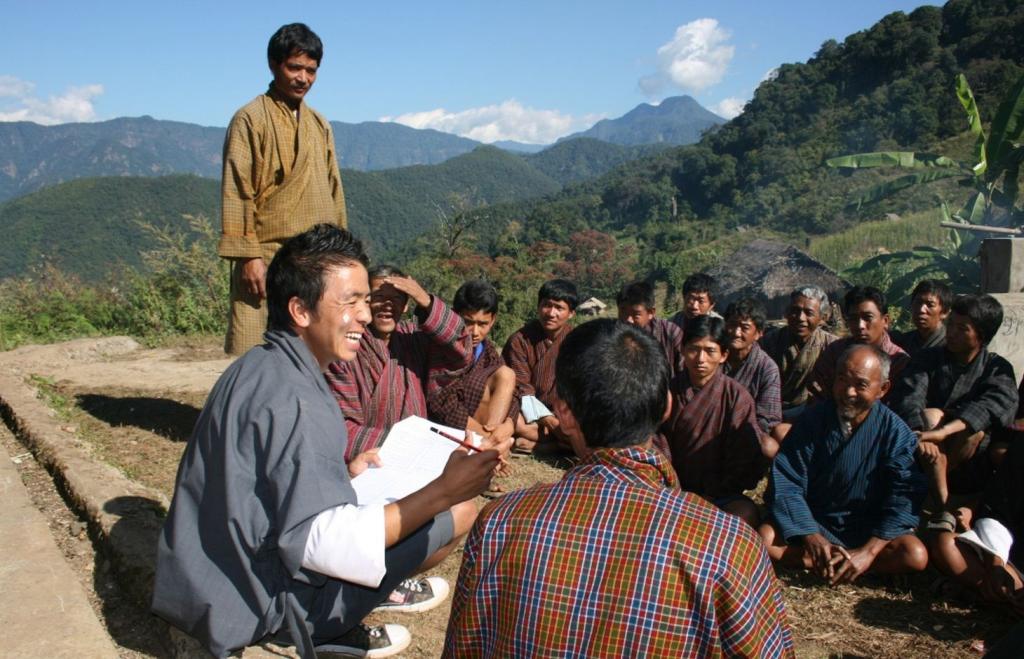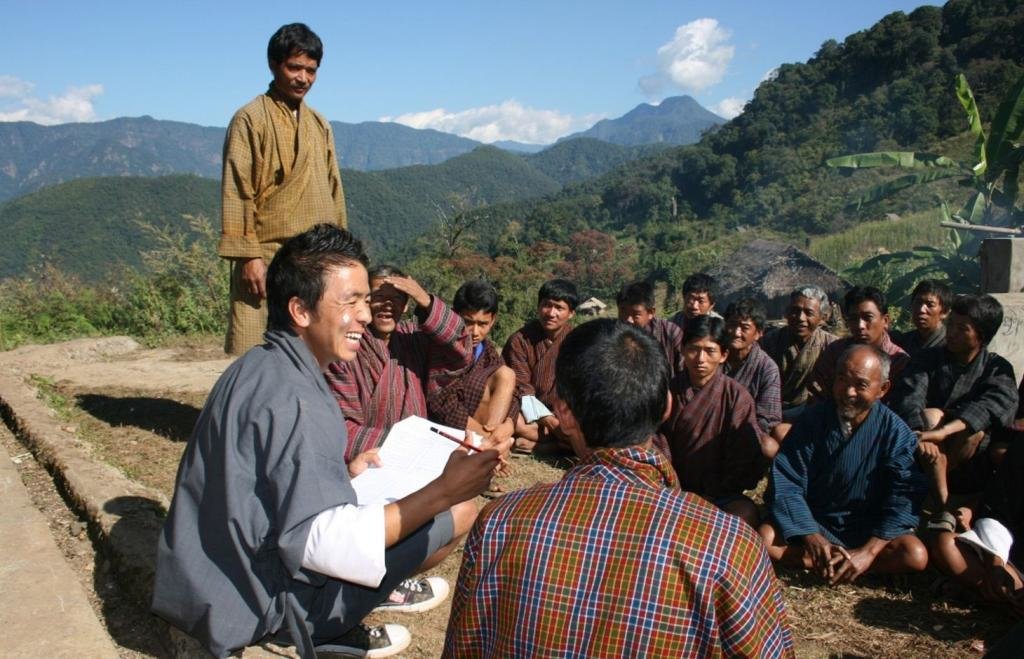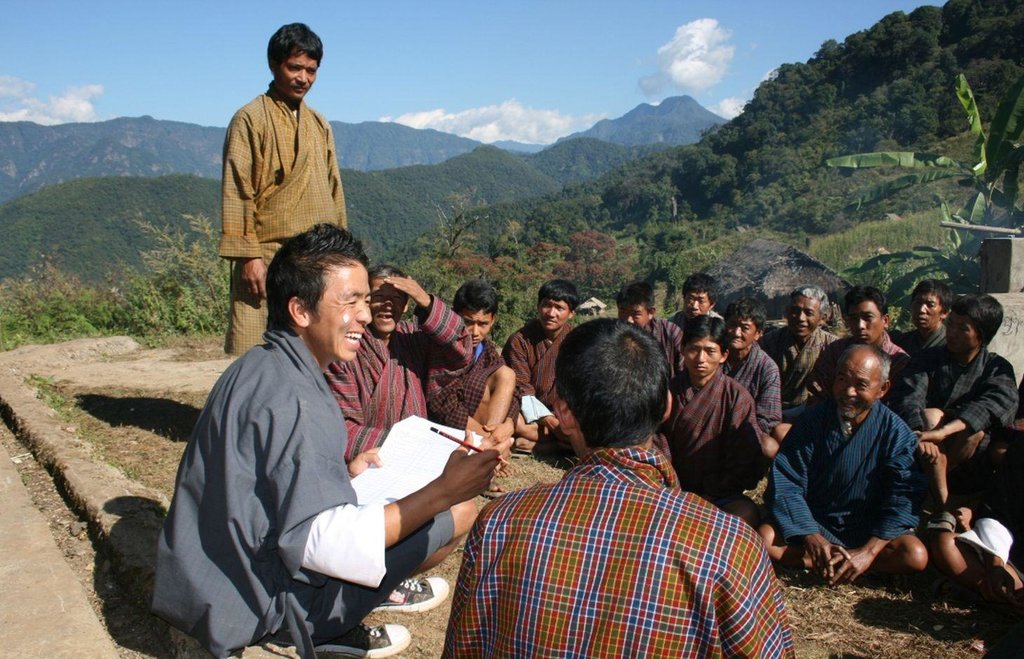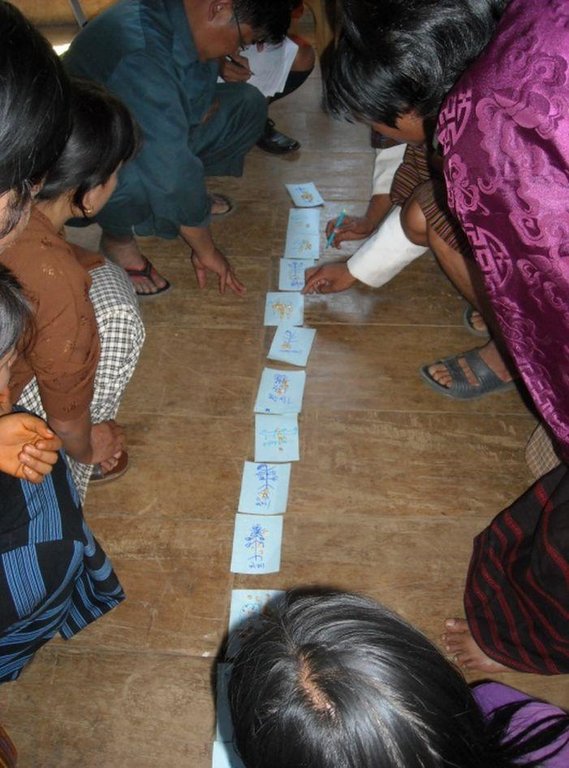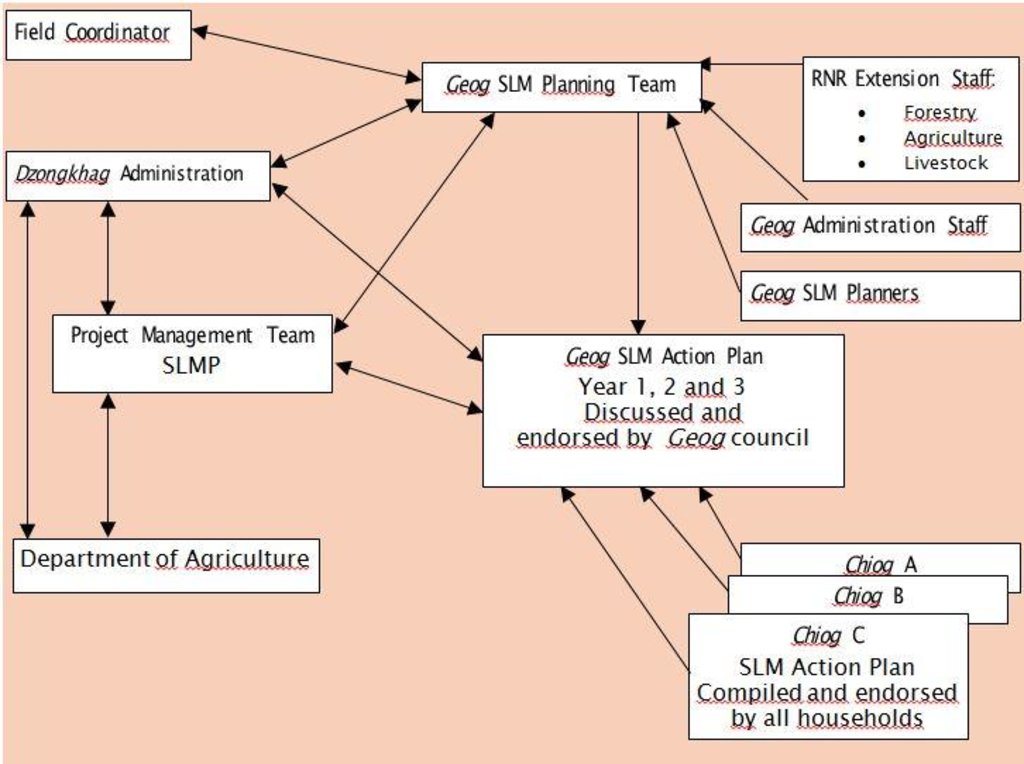Participatory SLM Action Planning [Бутан]
- Шинийг нээх:
- Шинэчлэх:
- Эмхэтгэгч: Karma Dorji
- Хянан тохиолдуулагч: –
- Хянагч: Fabian Ottiger
approaches_2489 - Бутан
Бүлгүүдийг үзэх
Бүгдийг дэлгэх Бүгдийг хаах1. Ерөнхий мэдээлэл
1.2 Арга барилыг баримтжуулах болон үнэлгээ хийхэд оролцсон хүн эсвэл байгууллагын холбоо барих хаяг
ГТМ мэргэжилтэн:
Wangdi Tashi
NSSC, DoA, MoAF, RGoB
Бутан
ГТМ мэргэжилтэн:
Dorji Tshering
NSSC, DoA, MoAF, RGoB
Бутан
Арга барилыг баримтжуулах/үнэлэх ажилд дэмжлэг үзүүлсэн байгууллага(ууд)-ын нэр (шаардлагатай бол)
National Soil Services Centre (National Soil Services Centre) - БутанАрга барилыг баримтжуулах/үнэлэх ажилд дэмжлэг үзүүлсэн байгууллага(ууд)-ын нэр (шаардлагатай бол)
MoA (MoA) - Бутан1.3 WOCAT-аар баримтжуулсан өгөгдлийг ашиглахтай холбоотой нөхцөл
Мэдээллийг хэзээ (газар дээр нь) цуглуулсан бэ?
14/03/2011
Эмхэтгэгч болон гол мэдээлэгч хүн(хүмүүс) WOCAT аргачлалаар баримтжуулсан мэдээллийг ашиглахтай холбоотой нөхцлийг хүлээн зөвшөөрсөн:
Тийм
2. ГТМ Арга барилын тодорхойлолт
2.1 Арга барилын товч тодорхойлолт
A methodology to identify in a participatory manner at village level land-based problems, its causal factors and mitigation measures to reduce land degradation and enhance rural livelihoods
2.2 Арга барилын дэлгэрэнгүй тодорхойлолт
Арга барилын дэлгэрэнгүй тодорхойлолт:
Aims / objectives: Participatory SLM Action Planning (SLM AP) is a methodology that aims at prioritiz-ing possible SLM interventions to mitigate the most critical land degradation issues. Priorities are based on the identification of land-based livelihoods and livelihood resources, the key area-based problems and their causes. SLM AP is carried out in the SLMP geogs (block) at chiog (village) level, including all community households. It involves elements of PRA/PLA such as problem census, cropping calendars, history lines, natural resource mapping and builds on the in-depth knowledge and understanding of farming households of their land, their problems and opportunities. The process is highly visual to include the illiterate and very interactive by giving the communities the lead in prioritizing their problems and deciding on SLM interventions.
Methods: The SLM AP is an iterative process, starting with building and training SLM planning teams (GSPTs) at geog level, comprising of extension staff and locally recruited geog SLM planners (GSPs) and geog administration staff. The GSPTs start awareness and mobilization activities in the first year at geog council level. This is followed by a 3 day SLM AP in each and every chiog of the geog to compile a chiog SLM action plan. The village SLM APs are combined into a geog SLM AP and discussed, amended and endorsed in a public meeting by the geog council. The necessary budget is allocated by SLMP project and implementation of the planned activities takes place at chiog level.
Stages of implementation: Implementation is preceded by intensive training and capacity building of the communities in SLM activities. In the second year a new SLM AP round is made, lasting only one day, with review of the previous SLM AP at chiog level. Potential new activities are identified, based on field experiences, to complete the new SLM AP for year 2. In the final year 3, a last SLM AP round is made in all chiogs to compile chiog and ultimately a geog SLM AP.
Role of stakeholders: SLM AP is an inclusive process and gender sensitive, with focus on vulnerable households. The approach includes participatory Natural Resource mapping at chiog level and participatory Monitoring & Evaluation to track implementation progress and impact and to get feedback of the communities.
Other important information: Environmental and social screening procedures are applied to exclude any negative impact on the land or on social groups. SLM AP was piloted in 3 geogs in 3 Dzongkhags since 2006 and has been rolled out to more than 130 chiogs in 9 geogs.
2.3 Арга барилын зурагууд
2.5 Арга барил нэвтрүүлсэн улс орон / бүс нутаг / байршил
Улс:
Бутан
Улс/аймаг/сум:
Chhukha, Trashigang and Zhemgang Dzongkhags
Байршлын дэлгэрэнгүй тодорхойлолт:
9 separate geogs
2.6 Арга барилыг эхлэх, дуусах огноо
Эхлэх жилийг тэмдэглэ:
2006
Хугацаа дуусах жил (Хэрэв арга барил удаанаар ашиглаагүй бол):
2012
2.7 Арга барилын төрөл
- төсөл / хөтөлбөр дээр үндэслэсэн
2.8 Арга барилын үндсэн зорилго, зорилтууд
The Approach focused mainly on SLM with other activities (livelihoods, cash income, food security, capacity building, awareness raising)
- To build community capacity to assess land degradation and identify and prioritize mitigation measures
- Enhancement of rural livelihoods
The SLM Approach addressed the following problems: - Lack of awareness of land degradation processes, combined with limited technical knowledge to tackle its causes.
- Planning procedures are top-down and do not incorporate land-based issues adequately and fail to build local ownership and sustainability.
2.9 Арга барилын хүрээнд хэрэгжсэн Технологи/Технологиудад дэмжсэн эсвэл саад учруулсан нөхцлүүд
санхүүгийн нөөц, үйлчилгээний хүртээмж / боломж
- Хазаарлалт
Large amount of cash to handle at municipality level
Treatment through the SLM Approach: Training, monitoring and limitation of cash amounts
Бүтэц зохион байгуулалт
- Хазаарлалт
Delays in financial releases to decentralised level because of lengthy/complicated administrative chain
Treatment through the SLM Approach: Training of key financial staff to shorten procedure and minimize frequency of budget releases
Хууль, эрхзүйн хүрээ (газар эзэмшил, газар, ус ашиглах эрх)
- Идэвхижүүлэх
The existing land ownership, land use rights / water rights helped a little the approach implementation: Individual land titles of households favour greatly the planning and implementation of SLM activities
- Хазаарлалт
Lack of efforts in implementing SLM technologies on land without ownership and living as tenants
Treatment through the SLM Approach: Awareness on the importance of proper management to prevent decline in productivity and their own livelihoods through loss of soil fertility and or loss of land physically due to landslides and mass movements.
ГТМ-ийн талаарх мэдлэг, техникийн дэмжлэг авах боломж
- Хазаарлалт
Awaraness of communities and technical confidence of teams
Treatment through the SLM Approach: Training and capacity buidling
ажлын багтаамж, хүн хүчний нөөц бололцоо
- Хазаарлалт
Large volume of work, especially in growing season
Treatment through the SLM Approach: Make of use of lean winter season for labour-intensive SLM interventions
Бусад
- Хазаарлалт
Small land holding sizes to spare a portion for SLM technologies
Treatment through the SLM Approach: Awareness on the advantages of SLM
3. Оролцогч талуудын оролцоо ба үүргүүд
3.1 Арга барилд оролцогч талууд болон тэдгээрийн үүргүүд
- Орон нутгийн газар ашиглагч / орон нутгийн иргэд
communities of all chiogs
In all villages the most vulnerable community members were identified (wealth / well-being ranking), ranked and specific effort made to include them in most interventions, where possible.
- ГТМ-ийн мэргэжилтэн/ хөдөө аж ахуйн зөвлөх
- Багш/ сурагч/ оюутан
- Орон нутгийн захиргаа
GSPT and Dzongkhag staff (Local government)
- Засгийн газар (шийдвэр гаргагч, төлөвлөгч)
RGoB, MoAF, DoA
- Олон улсын байгууллага
GEF, World Bank
- monk body
3.2 Арга барилын янз бүрийн үе шатанд орон нутгийн газар ашиглагчид / бүлэглэлүүдийг татан оролцуулах
| Орон нутгийн газар ашиглагч / орон нутгийн иргэдийн оролцоо | Хэн оролцсоныг тодорхойлж, үйл ажиллагааг тайлбарлана уу | |
|---|---|---|
| санаачлага/идэвхжүүлэлт | интерактив | National level stakeholders in consultation with district and municipality staff developed the methodology through an iterative consultation process |
| Төлөвлөгөө | интерактив | Decentralised training and planning of SLM interventions at chiog level (130+ chiogs) in 9 geogs in 3 Dzongkhags |
| Хэрэгжилт | интерактив | Range of SLM and livelihood activities at chiog level (130+ villages) during 6 year project period |
| Мониторинг/ үнэлгээ | интерактив | Regular participatory M&E at chiog and geog level |
| Research | идэвхигүй | Few focused SLM related research topics commissioned to governmental research institutions |
3.3 Диаграм (хэрэв боломжтой бол)
Тодорхойлолт:
Overview of network of Stakeholders at chiog (village), geog and district level
Зохиогч:
Hans van Noord (Schoutenkamp 43 Heteren The Netherlands)
3.4 ГТМ-ийн технологи/технологиуд сонгох шийдвэр
Хэрэгжүүлэх Технологи/Технологиудын сонголтыг хийж шийдвэр гаргасан хүнийг тодорхойлно уу:
- ГТМ-ийн мэргэжилтнүүдийн дэмжлэгтэйгээр, голчлон газар ашиглагчид
Тайлбар:
Decisions on the method of implementing the SLM Technology were made by mainly by SLM specialists with consultation of land users. The SLM planning was done in a very participatory manner with the land users as they best know the problems in their land i.e. where, how, when, etc. Planning done using participatory planning tools and field visits. Based on the problems at the site (site specific problems) then SLM Specialists make problem specific recommendations of SLM technologies. The main Monitoring and Evaluation was done after every six months when comprehensive information was collected with structured questionnaires along with site visits and meeting with the communities. M&E was also done as frequently as possible even while visiting the site for other purposes during the year without compulsory group meetings.
4. Техникийн дэмжлэг, чадавхи бүрдүүлэх, мэдлэгийн менежмент
4.1 Чадавхи бэхжүүлэх/сургалт
Газар эзэмшигчид / бусад оролцогч талуудад сургалт явуулсан уу?
Тийм
Хэн сургалтанд хамрагдсан бэ:
- Газар ашиглагчид
- хээрийн ажилтан / зөвлөх
- Project management staff
Сургалтын хэлбэр:
- Ажил дээр
- фермерээс -фермер
- үзүүлэнгийн талбай
- Олон нийтийн уулзалт
- курс дамжаа
Хамрагдсан сэвдүүд:
Extensive training programmes for project management staff and field coordinators and the decentralised extension staff (forestry, livestock and agriculture) at geog level together with the geog administration staff and finally to all chiog communities (130+). Initial training was on SLM action planning and Natural Resource mapping; later on a range of technical intervention such as hedgerow establishment, check dam construction, bioengineering, afforestation, community forestry, fodder development, bamboo plantation, bench terracing etc.
4.2 Зөвлөх үйлчилгээ
Газар ашиглагчдад зөвлөх үйлчилгээ авах боломжтой байдаг уу?
Тийм
Зөвлөх үйлчилгээ үзүүлсэн эсэхийг тогтоо:
- Газар ашиглагчийн талбай дээр
Тодорхойлолт / тайлбар:
Name of method used for advisory service: SLM planning knowledge transfer; Key elements: participatory planning, capacity and skills building of RNR extension staff; Whole range of extension advisory services by all extension teams related to SLM, cash generation and group formation
Advisory service is quite adequate to ensure the continuation of land conservation activities; Capacity built, awareness raised, institutions supported. Adequate human and institutional capacities and awareness have been created during the GEF/World Bank SLM Project period and the effort is still being continued. The actual implementation of the SLM technologies in the field is constrained by inadequate fund support and small land holdings.
4.3 Институцийг бэхжүүлэх (байгууллагын хөгжил)
Арга барилаар дамжуулан институц байгуулагдаж эсвэл бэхжсэн үү?
- Тийм, бага
Байгууллагууд бэхжиж, үүсэн бий болсон түвшин(үүд)-г тодорхойлно уу:
- Орон нутгийн
Дэмжлэгийн төрлийг ялга:
- чадавхи бэхжүүлэх / сургалт
- Тоног төхөөрөмж
- curriculum development support, seeds, seedlings
Дэлгэрэнгүй мэдээллийг өгнө үү:
Moderate support to monk body, schools, Non-Formal Education and geog administrations
4.4 Мониторинг ба үнэлгээ
Мониторинг болон үнэлгээ нь арга барилын хэсэг үү?
Тийм
Тайлбар:
bio-physical aspects were regular monitored by project staff through observations; indicators: Regular measurements and observations of acreage of improved vulnerable land through SLM interventions; annual soil erosion plot measurements
bio-physical aspects were regular monitored by project staff through measurements; indicators: Regular measurements and observations of acreage of improved vulnerable land through SLM interventions; annual soil erosion plot measurements
technical aspects were regular monitored by project staff through observations; indicators: Regular measurements and observations of acreage and properties of specific areas of improved vulnerable land
technical aspects were regular monitored by project staff through measurements; indicators: Regular measurements and observations of acreage and properties of specific areas of improved vulnerable land
socio-cultural aspects were regular monitored by project staff, land users through observations; indicators: Regular observations through participatory M&E meetings
economic / production aspects were regular monitored by project staff through observations; indicators: Regular observations and measurements by field extension staff (crop cut, animal production, volume of bamboo marketed; CBA study to establish economic viability
economic / production aspects were regular monitored by project staff through measurements; indicators: Regular observations and measurements by field extension staff (crop cut, animal production, volume of bamboo marketed; CBA study to establish economic viability
area treated aspects were regular monitored by project staff, land users through measurements; indicators: Regular measurements of area treated: range of project indicators for vulnerable land improved
no. of land users involved aspects were ad hoc monitored by project staff, government through measurements; indicators: Regular measurements of households and farmers (male/female) participating
management of Approach aspects were regular monitored by None through observations; indicators: WB, MTAC, Regular reviews with key stakeholders (Annual Review Workshops)
There were several changes in the Approach as a result of monitoring and evaluation: Two-tier approach: combination of inclusion of all household combined with limited areal focus; vulnerable households focus; financial disbursement system; ch more cash-generating activities; more group/community focus; labour-saving machinery
There were few changes in the Technology as a result of monitoring and evaluation: change of type and variety of seeds and seedlings
4.5 Судалгаа
Судалгаа арга барилын хэсэг нь байсан уу?
Тийм
Сэдвийг тодруулна уу:
- Социологи
- Эдийн засаг/ зах зээл
- Экологи
Дэлгэрэнгүй мэдээллийг өгч, хэн судалгаа явуулсныг бичнэ үү:
Little involvement, apart from some focused research on group formation at chiog level and studies on CBA, SLM-poverty linkage, rangeland management, rural-urban transition etc.
Research was carried out both on station and on-farm
5. Санхүүгийн болон гадаад материаллаг дэмжлэг
5.1 ГТМ-ийн Арга барилын бүрэлдэхүүн хэсгийн жилийн төсөв
Хэрэв жилийн төсөв тодорхойгүй бол хягаарыг тодруулна уу:
- > 1,000,000
Тайлбар (жнь: санхүүжилтийн гол эх үүсвэр / гол хандивлагчид):
Approach costs were met by the following donors: international (GEF-World Bank): 70.0%; government (RGoB): 20.0%; local community / land user(s): 10.0%
5.2 Газар ашиглагчдад санхүүгийн / материаллаг дэмжлэг үзүүлсэн
Технологи / технологийг хэрэгжүүлэхэд газар ашиглагчид санхүүгийн / материаллаг дэмжлэг авсан уу?
Тийм
Хэрэв тийм бол дэмжлэгийн төрөл(үүд), нөхцөл, болон нийлүүлэгч(чид) бичнэ үү:
Incentives for specific SLM interventions per area and through short-term input support (seeds and seedlings)
5.3 Тодорхой зардлыг даахад чиглэсэн дэмжлэгт (хөдөлмөрийн хүчийг оролцуулаад)
- Тоног төхөөрөмж
| Ямар хөрөнгө оруулалт татаасаар олгогдсоныг заана уу | Ямар талбайн хэмжээнд | Тэтгэмж, урамшууллыг тодорхойлно уу |
|---|---|---|
| Багажууд | хэсэгчлэн санхүүждэг | |
- Хөдөө аж ахуй
| Ямар хөрөнгө оруулалт татаасаар олгогдсоныг заана уу | Ямар талбайн хэмжээнд | Тэтгэмж, урамшууллыг тодорхойлно уу |
|---|---|---|
| Үр, үрсэлгээ | хэсэгчлэн санхүүждэг | |
| Seedlings | хэсэгчлэн санхүүждэг | |
- Барилга байгууламж
| Ямар хөрөнгө оруулалт татаасаар олгогдсоныг заана уу | Ямар талбайн хэмжээнд | Тэтгэмж, урамшууллыг тодорхойлно уу |
|---|---|---|
| for fencing and dams | хэсэгчлэн санхүүждэг | |
- Дэд бүтэц
| Ямар хөрөнгө оруулалт татаасаар олгогдсоныг заана уу | Ямар талбайн хэмжээнд | Тэтгэмж, урамшууллыг тодорхойлно уу |
|---|---|---|
| FYM sheds, irrigation channel renovation | хэсэгчлэн санхүүждэг | |
Тайлбар:
Mostly voluntary and some paid in cash (for labour-intensive SLM interventions) and limited other material support such as tools and seeds and seedlings
Not financed: roads, fertilizers, schools
5.4 Кредит
Арга барилын хүрээнд ГТМ-ийн үйл ажиллагаанд зориулж зээлд хамрагдсан уу?
Үгүй
6. Нөлөөллийн дүн шинжилгээ ба дүгнэлт
6.1 Арга барилын нөлөөллүүд
Арга барил нь ГТМ-ийн технологийг хэрэгжүүлж, хадгалахад газар ашиглагчдад тусласан уу?
- Үгүй
- Тийм, бага зэрэг
- Тийм, зарим
- Тийм, их
Considerable area of vulnerable land brought under SLM, reduction of loss of land, improved yields, improved income, improved animal production, improved fodder base
Арга барил нь эмзэг бүлгийнхнийг нийгэм, эдийн засгийн хувьд чадавхижуулсан уу?
- Үгүй
- Тийм, бага зэрэг
- Тийм, зарим
- Тийм, их
Moderate improvement of vulnerable households (poorest and single-headed households) through targeted interventions and pro-active inclusion. The labour sharing approach in implementing SLM activities greatly benefited the resource (human and capital) constrained household.
Арга барил нь ГТМ-ийн технологийг хэрэгжүүлэхэд саад учруулсан газрын эзэмшил / ашиглах эрхийг сайжруулахад чиглэсэн үү?
- Үгүй
- Тийм, бага зэрэг
- Тийм, зарим
- Тийм, их
The problem is unlikely to be overcome in the near future. Individual land titles of households favour greatly the planning and implementation of SLM activities
Did other land users / projects adopt the Approach?
- Үгүй
- Тийм, бага зэрэг
- Тийм, зарим
- Тийм, их
Other government and donor-funded projects have adopted elements of the participatory SLM action planning methodology (DANIDA, REAP)
Did the Approach lead to improved livelihoods / human well-being?
- Үгүй
- Тийм, бага зэрэг
- Тийм, зарим
- Тийм, их
cash income, food self-sufficiency, community sense/bonding, reduced exposure to natural hazards related to land degradation/flooding
Did the Approach help to alleviate poverty?
- Үгүй
- Тийм, бага зэрэг
- Тийм, зарим
- Тийм, их
Improvement of food self-sufficiency and cash generation opportunities
6.2 ГТМ-ийг хэрэгжүүлэх газар ашиглагчидын гол санаачилга
- үйлдвэрлэл нэмэгдсэн
- Ажлын ачаалал бууруулсан
- төлбөр / татаас
- нэр хүнд, нийгмийн дарамт / нийгмийн холбоо
- Сүлжээ/ бүлэг төсөл/ хөдөлгөөнд гишүүнээр элсүүлэх
- Байгаль орчны ухамсар
- well-being and livelihoods improvement
6.3 Арга барилын үйл ажиллагааны тогтвортой байдал
Газар ашиглагчид арга барилаар дамжуулан хэрэгжүүлсэн арга хэмжээг тогтвортой хадгалж чадах уу (гадны дэмжлэггүйгээр)?
- Тодорхойгүй
Хэрэв үгүй эсвэл тодорхойгүй бол дэлгэрэнгүй тайлбар өгнө үү:
Rural communities will need continued support by government staff through advice, finance and other support.
6.4 Арга барилын тогтвортой/давуу тал/боломжууд
| Эмхэтгэгч, бусад мэдээлэл өгсөн хүмүүсийн өнцгөөс тодорхойлсон давуу тал/боломжууд |
|---|
|
Decentralised, village level bottom-up planning and implementation ensures capacity building, ownership and empowerment of rural land users Participatory character gives a voice to farmers with in-depth knowledge of land-based issues and its causes and history Inclusiveness of approach, reaching to all households Helps to build community sense (How to sustain/ enhance this strength: Continued annual AP Continued annual AP; add with NR mapping and ITK studies and participatory M&E Continued annual AP; targeted focus on most vulnerable households Additional group formation and community group support ) |
6.5 Арга барилын дутагдалтай/сул тал/аюул болон тэдгээрийн хэрхэн даван туулах арга замууд
| Эмхэтгэгч, бусад мэдээлэл өгсөн хүмүүсийн өнцгөөс тодорхойлсон сул тал/ дутагдал/ эрсдэл | Тэдгээрийг хэрхэн даван туулах вэ? |
|---|---|
|
Time-consuming and resource demanding Requires large workload of both extension staff and farmers Costly as the approach also covers actual implementation of all of planned SLM activities and reaches more than 130 villages for 3 year period |
Combine and align with Five Year Plan planning procedures; mainstreaming into governmental decentralised planning procedures Mainstreaming into regular planning and budgeting Spread over calendar year; labour-intensive SLM activities in lean winter season. |
7. Суурь мэдээлэл болон холбоосууд
7.1 Мэдээллийн эх үүсвэр/аргууд
- Хээрийн уулзалт, судалгаа
- Газар ашиглагчтай хийсэн ярилцлага
7.2 Холбогдох бүтээлийн ишлэл
Гарчиг, зохиогч, он, ISBN:
Working the Land - Documenting the Key Lessons of Sustainable Land Management on Steep to Very Steep Slopes in Bhutan 2011
Хаанаас авч болох вэ? Зардал?
NSSC, DoA, MoAF, RGoB
Гарчиг, зохиогч, он, ISBN:
Indigenous Technical Knowledge (ITK) on Soil & Soil Fertility Management 2011
Хаанаас авч болох вэ? Зардал?
NSSC, DoA, MoAF, RGoB
Гарчиг, зохиогч, он, ISBN:
Participatory Approaches in Sustainable Land Management – Planning, Implementation & Monitoring as Continuous Learning Processes 2011
Хаанаас авч болох вэ? Зардал?
NSSC, DoA, MoAF, RGoB
Гарчиг, зохиогч, он, ISBN:
National Action Plan to Combat Land Degradation 2010, 2014
Хаанаас авч болох вэ? Зардал?
NSSC, DoA, MoAF, RGoB
Гарчиг, зохиогч, он, ISBN:
BHUCAT, Best Practices and Guidelines from Bhutan for SLM on Steep to very Steep Slope
Хаанаас авч болох вэ? Зардал?
NSSC, DoA, MoAF, RGoB
Гарчиг, зохиогч, он, ISBN:
Documentary of the achievements made in SLM through SLM Project
Хаанаас авч болох вэ? Зардал?
NSSC, DoA, MoAF, RGoB
Гарчиг, зохиогч, он, ISBN:
Bhutan Land Cover Assessment 2010-Technical Report, NSSC, 2011
Хаанаас авч болох вэ? Зардал?
NSSC, DoA, MoAF, RGoB
Гарчиг, зохиогч, он, ISBN:
Soil Erosion – Measurement and analysis of soil erosion plot data, NSSC, 2010, 2011
Хаанаас авч болох вэ? Зардал?
NSSC, DoA, MoAF, RGoB
Гарчиг, зохиогч, он, ISBN:
Integrated Biodiversity Survey of the Lower Wangchhu Watershed, Bhutan 2010
Хаанаас авч болох вэ? Зардал?
NSSC, DoA, MoAF, RGoB
Гарчиг, зохиогч, он, ISBN:
Rangeland Management in Bhutan 2009
Хаанаас авч болох вэ? Зардал?
NSSC, DoA, MoAF, RGoB, A consultancy report
Гарчиг, зохиогч, он, ISBN:
Study on Poverty Sustainable Land Management Linkages in Bhutan-A consultancy Report-2009 2009
Хаанаас авч болох вэ? Зардал?
NSSC, DoA, MoAF, RGoB, A consultancy report
Гарчиг, зохиогч, он, ISBN:
Sustainable Land Management Participatory Action Planning Manual & Tool Kit 2009
Хаанаас авч болох вэ? Зардал?
NSSC, DoA, MoAF, RGoB, A consultancy report
Гарчиг, зохиогч, он, ISBN:
Sustainable Land Management Interventions: Cost Benefit Analysis Report 2009
Хаанаас авч болох вэ? Зардал?
NSSC, DoA, MoAF, RGoB, A consultancy report
Гарчиг, зохиогч, он, ISBN:
Rural Livelihoods and Peri-Urban Analysis 2008
Хаанаас авч болох вэ? Зардал?
NSSC, DoA, MoAF, RGoB, A consultancy report
Гарчиг, зохиогч, он, ISBN:
Review of Mainstreaming of sustainable Land Management in Government Policies and Plans in Bhutan 2008
Хаанаас авч болох вэ? Зардал?
NSSC, DoA, MoAF, RGoB, A consultancy report
Холбоос ба модулууд
Бүгдийг дэлгэх Бүгдийг хаахХолбоосууд
Холбоос байхгүй байна
Модулууд
Модуль байхгүй байна


